National Weed Appreciation Day Date in the current year: March 28, 2025
 National Weed Appreciation Day is celebrated every March 28 to remind people that, while weeds can be incredibly annoying, they are actually beneficial to many ecosystems around the world.
National Weed Appreciation Day is celebrated every March 28 to remind people that, while weeds can be incredibly annoying, they are actually beneficial to many ecosystems around the world.The term “weed” generally has a negative connotation, but it simply denotes a plant that grows where it is not supposed to grow; in some cases, it is applied to invasive species that reproduce aggressively outside of their natural habitat. The concept of weeds is mainly relevant in human-controlled settings such as farmlands, gardens, orchards, parks, lawns, industrial and residential areas, etc. It doesn’t have any significance from the botanical point of view because plants that are regarded as weeds in one situation may be viewed as desirable in another.
Many plants that are generally thought to be weeds have various beneficial properties and are therefore called beneficial weeds. For example, a number of plants that are primarily known as weeds can act as companion plants in agriculture and gardening. They may provide habitat for beneficial insects, keep pests at bay, provide protective shelter, act as a “living mulch” by reducing moisture loss and preventing erosion, release ethylene that helps fruit to ripen, etc.
Some weeds contribute to soil health. For example, white clover and other wild legumes are colonized by symbiotic bacteria that fix nitrogen from the air and capture it in the soil. Weeds with a strong, widespread root system introduce organic matter to soils, making them more fertile. In addition, some crops with relatively weak roots can “piggyback” on neighboring weeds and get nutrients and moisture from the deeper layers of soil.
Beneficial weeds also include wild plants with edible berries, roots or leaves, such as blackberry, nettle, crow garlic, wild mustard, dandelion, purslane, sheep sorrel, curly dock, wood sorrel, lamb’s quarters, chickweed, plantain, violets, chicory, burdock, cornflower, flatweed, horsetail, shepherd’s purse, and watercress. Dandelions were introduced to North America specifically as a source of food and for their medicinal benefits.
Some weeds have medicinal or cosmetic properties. For example, burdock root oil extract and stinging nettle infusion have traditionally been used in some parts of Europe as hair loss treatments, and dandelion roots have been used in traditional medicine due to their diuretic effect.
The origins of National Weed Appreciation Day are murky, but its goal is clear: someone established the holiday to remind people that weeds aren’t inherently bad and raise awareness of the benefits of weeds for us and our ecosystems. Remember: everything depends on the context, and even poisonous plants can be beneficial in certain situations.
You can celebrate National Weed Appreciation Day by learning about the benefits of the plants you’ve only ever known as weeds, identifying the weeds that grow in your garden or neighborhood and exploring their benefits, cooking with edible weeds, and spreading the word on social media with the hashtags #NationalWeedAppreciationDay and #WeedAppreciationDay.
- Category
- Ecological Observances, Unofficial Holidays
- Country
- USA
- Tags
- National Weed Appreciation Day, unofficial holidays, environmental observances, observances in the US, beneficial weeds